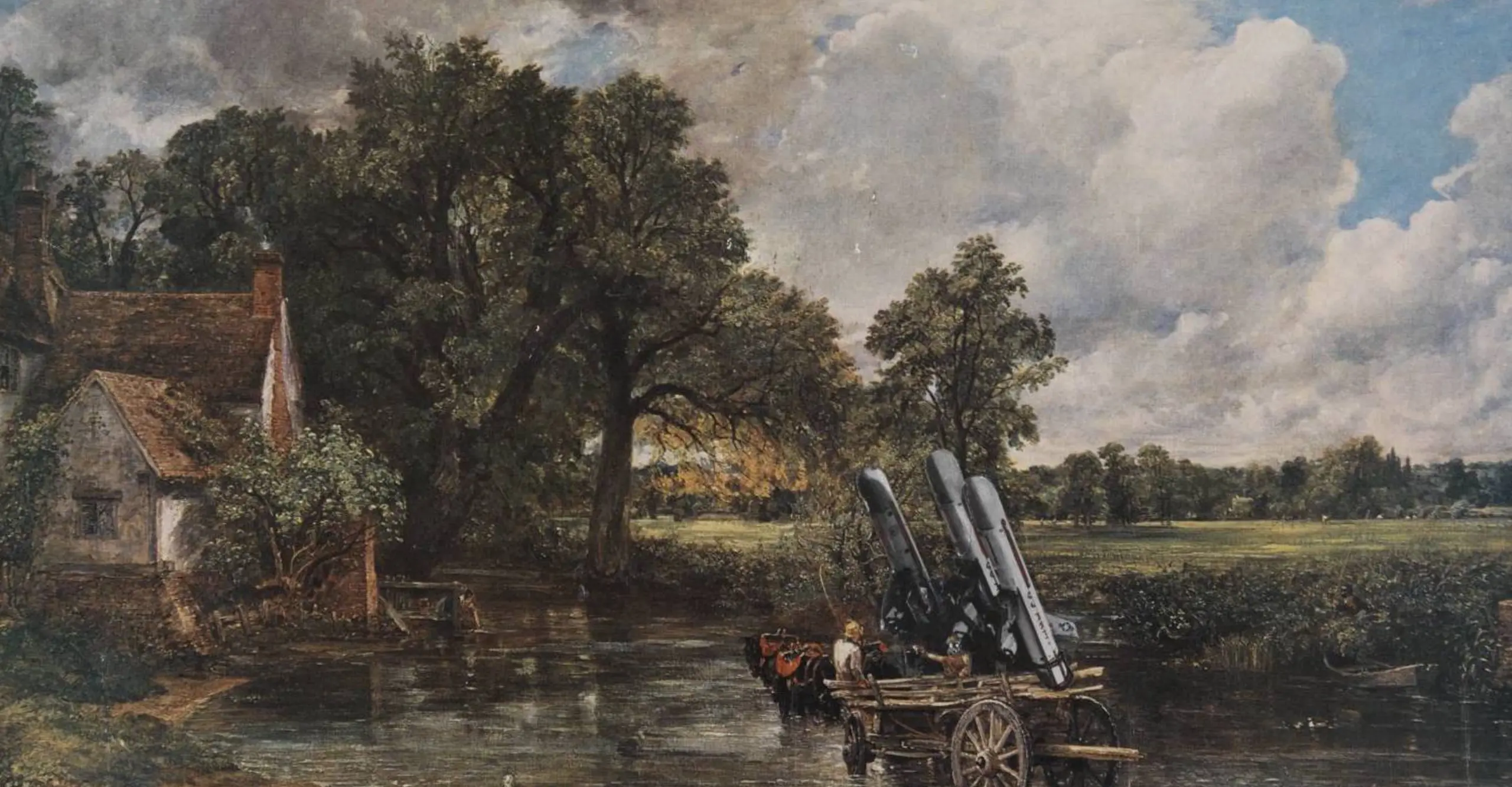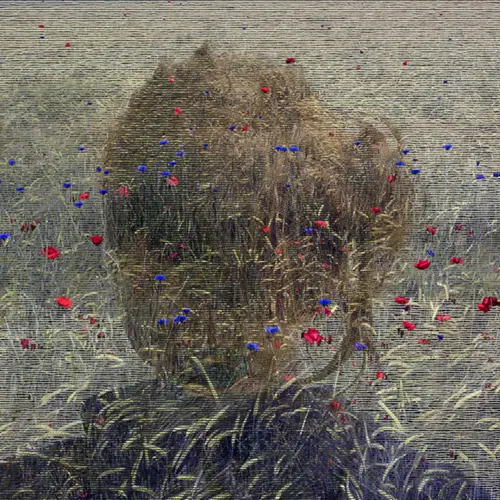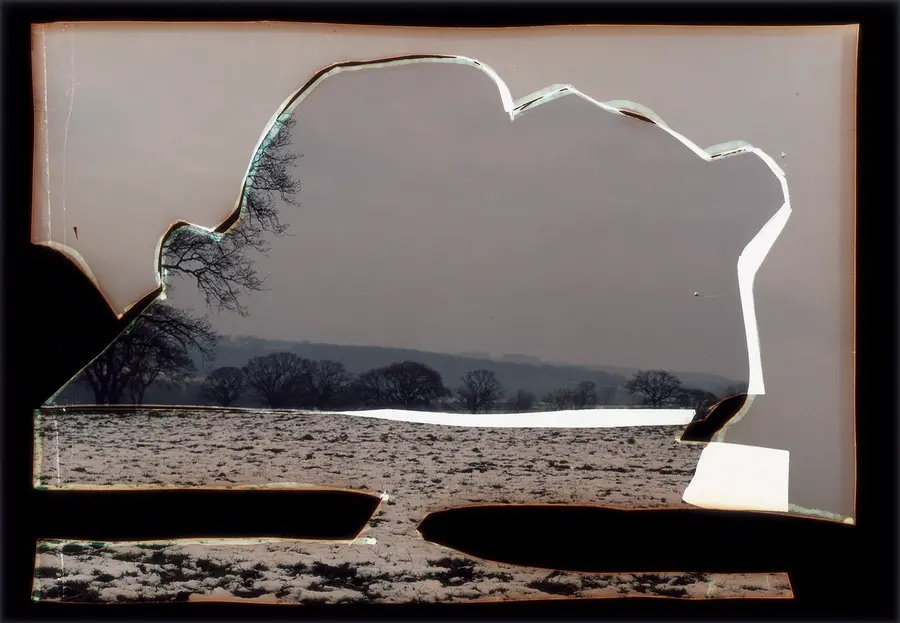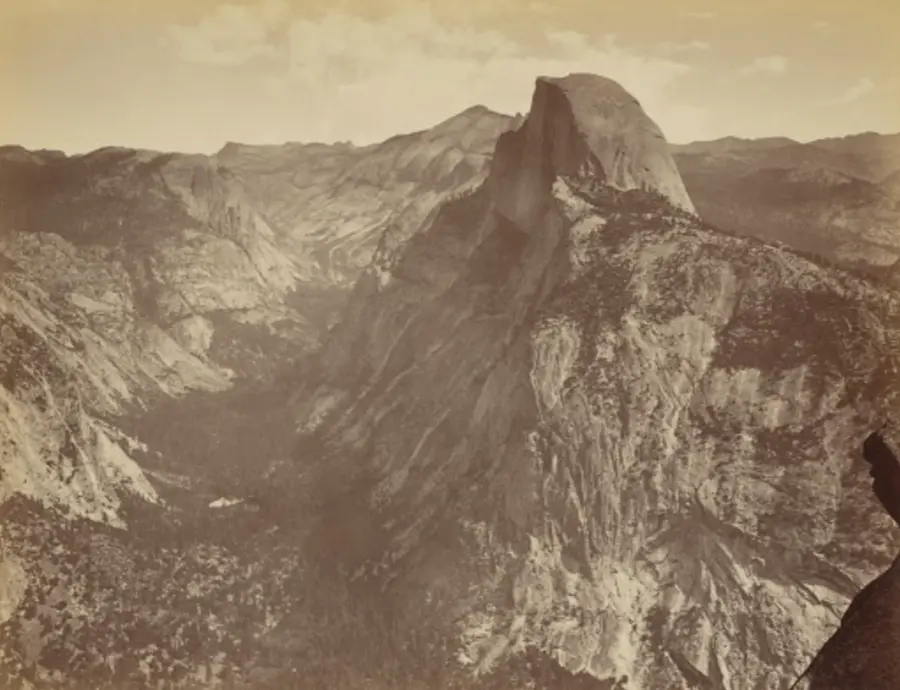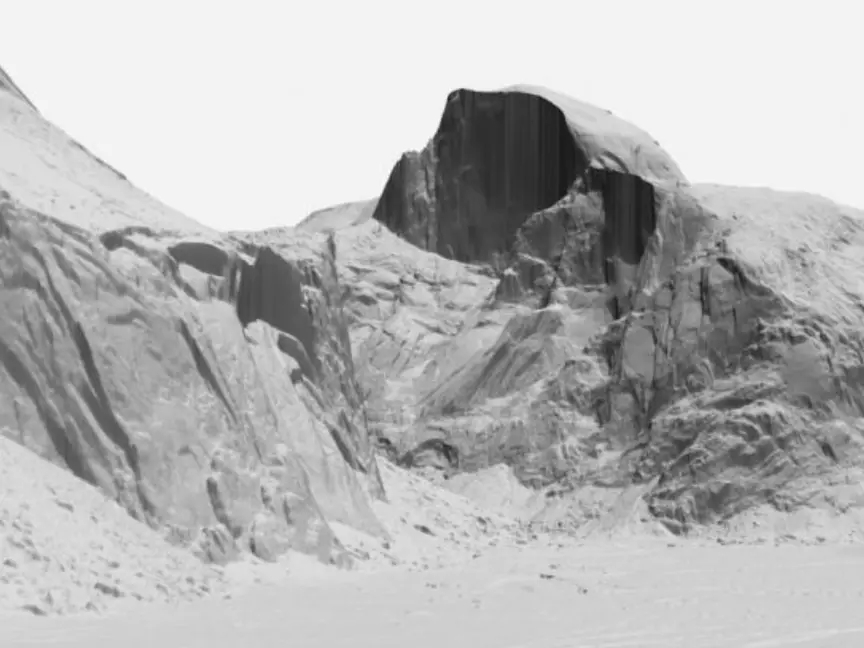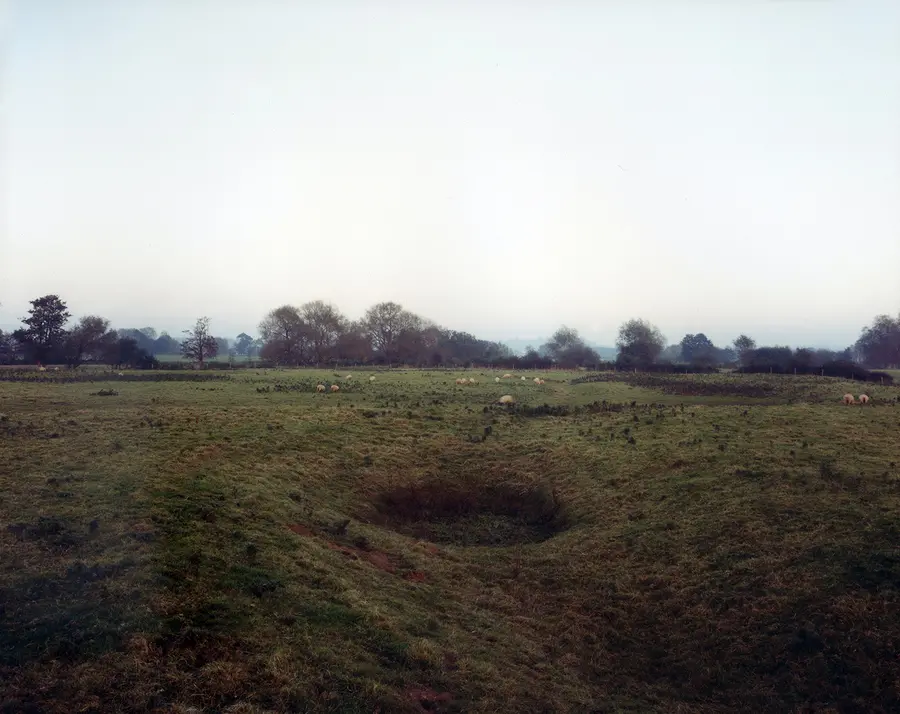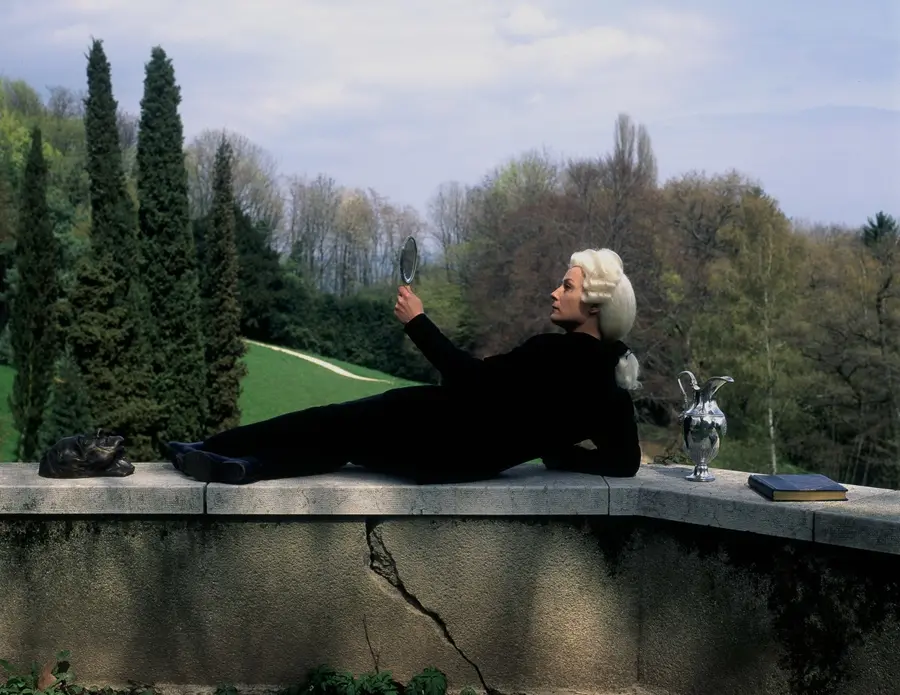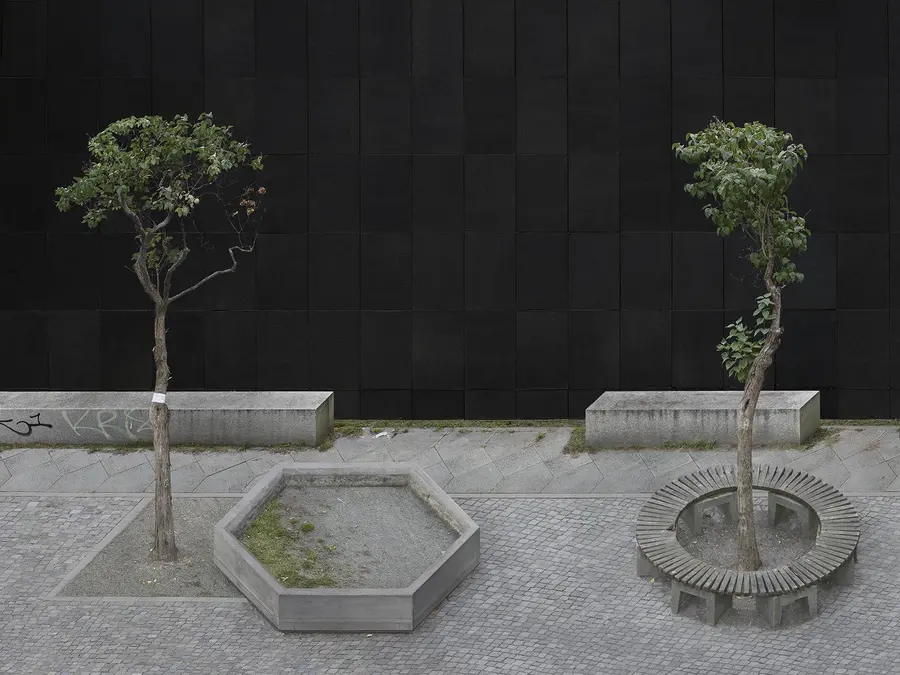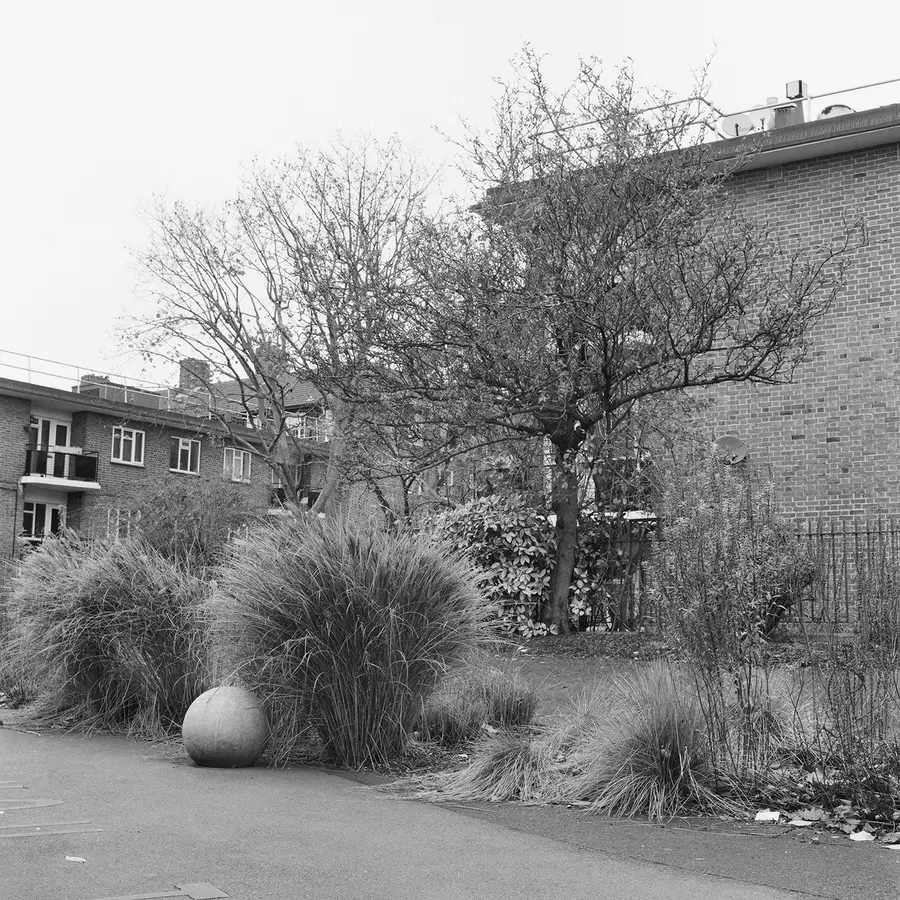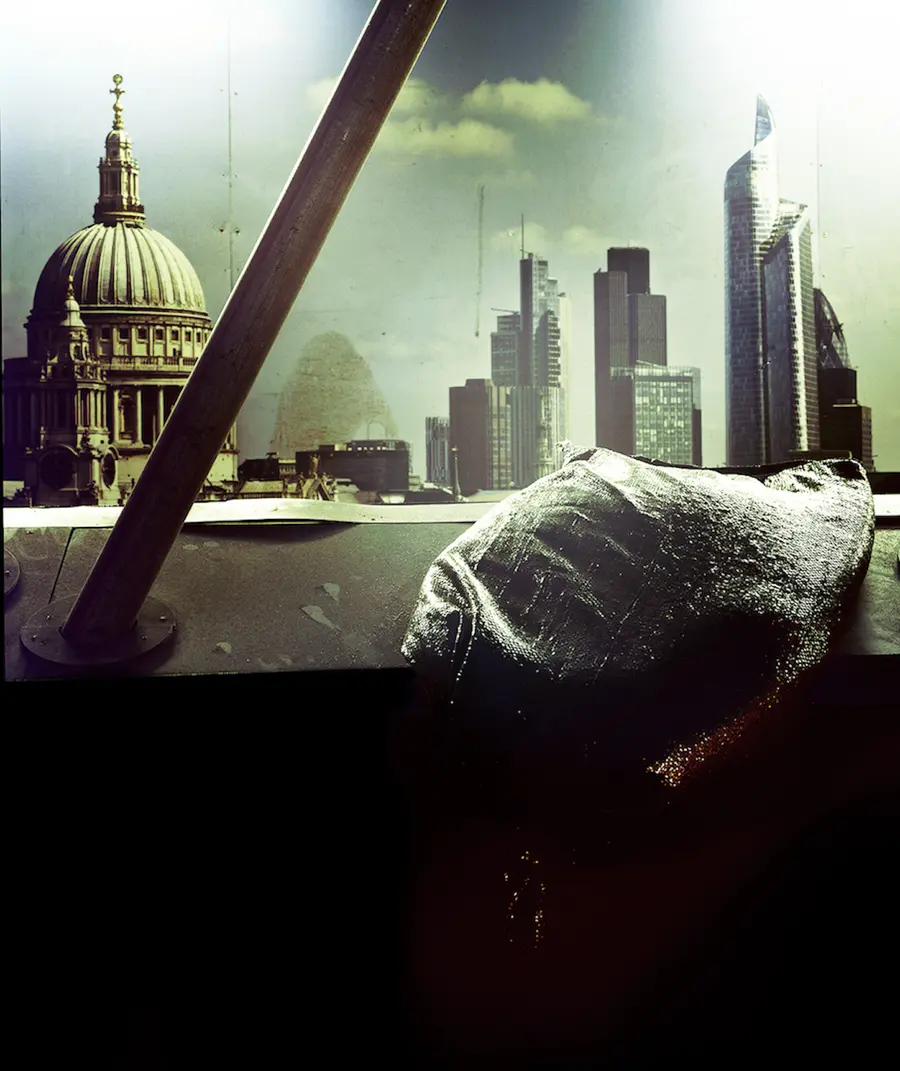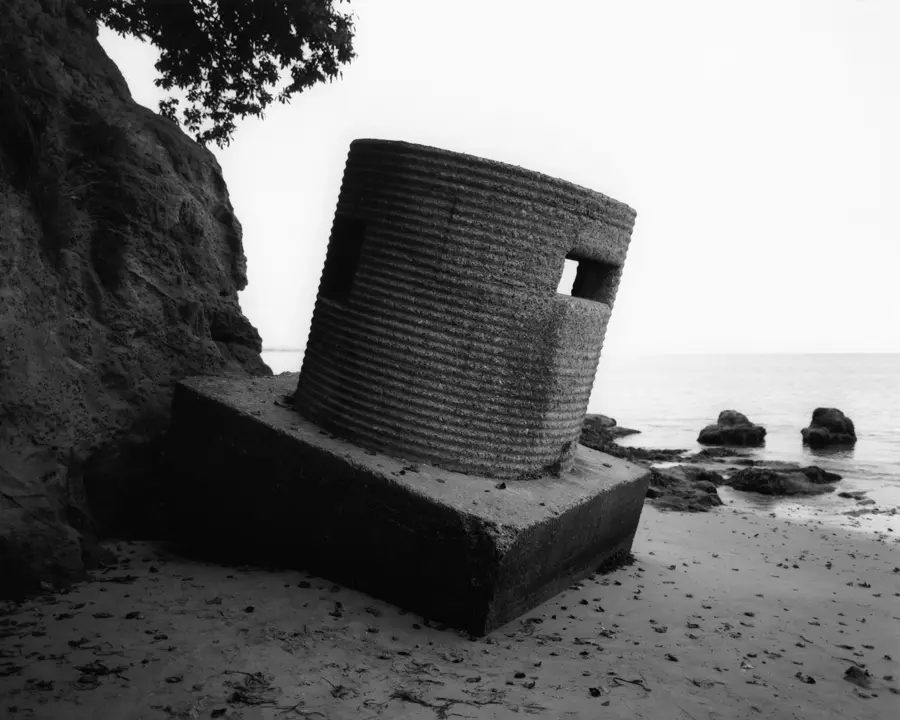In this essay, artist and senior lecturer Fergus Heron explores the rich relationship between landscape and photography.
In the series Beyond the View by artist Helen Sear, with assemblies of layered photographs we are offered a possibility of considering landscape as an idea. Central to each work in the series is a spectator looking — seemingly drawn to a horizon — and situated within a composition that complicates conventional expectations of what a landscape picture is. Traditional relations of foreground, background, surface, depth, subject and setting are reworked. Landscape, this work suggests, is a perceptual process; exceeding purely visual experience, it occurs, through a combination of embodied presence and imaginative engagement in which the subject of a picture includes the act of looking.
Landscape is also actively productive of photographic imagery in many different ways. In the work of Susan Derges, photographic paper, often in large sheets, is submerged in rivers, or in more recent work, constructed aquatic environments. Materials are exposed to a combination of natural and artificial light. The work invites intense analytical looking with the quality of printed detail it contains and is at the same time, mesmerising and wonderous. Dafna Talmor’s Constructed Landscapes is a project developed intuitively from a desire to work outside of landscape traditions while continuing to compulsively photograph places of personal significance, driven by instinct and sentiment. Collages are made from negatives exposed in camera in numerous locations, reconfigured to transform images from specific places into pictures of imaginary universal spaces. The process of combining different sections of negative into new negatives before printing produces lines and gaps in the finished print that reveal and comment upon their own construction process and emphasise the constructed character of landscape as photograph. Landscape, these works suggest in different ways, even before materialisation as a photograph, is an object of desire; active in defining different natures and ideas of place.
Landscape, like photography, is a relatively modern idea. Around the mid nineteenth century, the invention of photography revealed that cultures were prepared to form knowledge, beliefs and fantasies through optical, mechanically produced — and reproducible — images. During this time, industrialisation began a process of changing where people lived, according to how people worked. Within such broad transformative change, more specifically, economically advanced industrial nations engaged in colonial expansion; railways introduced unprecedented speed of travel and early forms of international tourism developed. Relatively distant places were experienced and seen according to social attitudes and cultural impressions. Images from distant places influenced how familiar places came to be depicted. As processes of habitation, work and travel altered through modernisation, detachment and distance began to characterise human relations to place. Land became increasingly perceived as landscape, and landscape increasingly encountered as picture — as much as, if not more than, any direct experience of place or nature. Photographs became established amidst a variety of forms of landscape pictures.
Perhaps the most commonly perceived kind of photograph understood as an example of landscape photography is the topographic photograph. As an adjective, topography describes the arrangement or accurate representation of the physical features of an area and the character of a work of art depicting places in a realistic and detailed manner. According to Miles Orvell, the topographic photograph is descriptive, more so than other kinds of landscape photographs, including the view photograph, that renders scenery as spectacle, and the aesthetic landscape photograph, characterised by the artistic vision of the photographer. Furthermore, the topographic photograph is usually part of a larger discourse, often political or scientific. These kinds of categories, Orvell suggests, provide useful distinctions, but they are also arbitrary and can overlap in any specific example of a body of work by an individual photographer.
The first topographic landscape photographs were made in the second half of the nineteenth century as industrialised western economies including the United States of America and Great Britain used photography in what were known as topographic surveys, carried out to produce detailed visual descriptions of land for purposes including the development of irrigation systems and railways, mining for natural resources and recording architectural and archaeological sites, some for state archives and libraries, others for corporate uses.
In the mid to late twentieth century, early survey photographs partly inspired photographers emerging from art colleges, concerned with questions around the capabilities of photography to address converging aesthetic and environmental issues. Selected examples of work by these photographers were included in a highly influential exhibition called New Topographics that took place in 1975 at The George Eastman House Museum of Photography in Rochester, New York, USA. The exhibition brought together works, critical in intent, that signaled new attitudes towards land use and development, in which the effects of human intervention were explicit and conventional conceptions of what could be termed as nature, involved renewed cultural consciousness of the effect of technology and commerce on the land. Work included in New Topographics depicted landscapes of an emerging post-modern era.
Another significantly influential practice from the 1970s is The Re-photographic Survey Project that paired celebrated nineteenth-century survey photographs of the American West with contemporary views from precisely the same vantage points made just over a century later, between 1977 and 1979. As a photographic strategy, this enables imaginative re-inhabitation of a nineteenth-century point of view, contemplation of the significance of visible changes and continuities, as well as the function of landscape photographs as pictures that exceed simple recording, towards influencing attitudes and beliefs.
Contemporary photography that can be seen in connection includes the work of Jem Southam, known for making extended series of photographs through patient observation of continuities and changes, often at a single location over months or years. Southam’s work is made primarily, though not exclusively, close to where he lives in South West England and explores interrelated personal, cultural, political, scientific and psychological concerns. Similarly, the work of Guy Moreton involves connections to particular places with a focus on visible and invisible traces, landmarks and ruins. Moreton’s pictures reference specific artistic, literary and philosophical work related to sites across northern Europe, ranging from Norway and Scotland to the North, East and South of England. Both Southam and Moreton make highly descriptive detailed photographs with powerful aesthetic qualities that also contain a great deal of visual information, enabling the viewer to deliberately and slowly register features of a picture. Their work demonstrates considered and systematic approaches to picture making towards knowing a place. Seeing topographic photographs produced through these processes can imbue the world in its stillness with a kind of mystery and wonder, qualities that may intensify as time between making and viewing increases. Topographic photographs can be both accurate visual records and contemplative, evocative pictures that stimulate the imagination.
Topographic photographs, historical or contemporary, can demonstrate certain ways of framing land inherited from landscape painting. Aesthetic ideas such as the picturesque and the sublime, have informed thinking of what a landscape is and how we look at it. These ideas formed a basis for early landscape photography as well as recent critical and reflective practices dealing with how land today might be inhabited and depicted. Picturesque is a word of Italian origin referring to the view of a painter. It developed as a theory around 1730 and took various forms over the course of the eighteenth and nineteenth centuries in poetry and literature to drawing and painting. Early tourists on what were known as Grand Tours decorated their homes with paintings bought from travels to areas around the Mediterranean Sea. These paintings influenced landscape designers in creating country gardens intended to resemble the paintings. As pictures became a basis for landscape gardens, the usual expectation that pictures represent an already existing world was reversed; the world itself became organised according to pictures.
The picturesque is a complex, changing and multi-layered idea. Malcolm Andrews proposes the picturesque involved an attitude that anticipated photography. Picturesque thinking appreciates landscape as resembling known works of art, but at the same time, appreciates natural scenery remote from art and artifice. It favours order and celebrates the wild and spontaneous. The picturesque domesticates the uncultivated, familiarises and commodifies. The process of framing views, integral to picturesque imagining, involved the use of pre-photographic optical devices that included the Claude Glass; a compact hand held tinted mirror, the Camera Obscura; a dark box, and the Camera Lucida; a lens that focused a view onto paper for drawing.
Photographers working across a broad historical trajectory, including Benjamin Brecknell Turner in the nineteenth century, and more recently, Keith Arnatt, John Kippin, Ingrid Pollard and Emma Wieslander reference the picturesque in different ways in their work, as influence, comment and critique. The artist Peter Kennard, known for politically motivated photomontages, reworked a reproduction of John Constable’s famous landscape painting. In Haywain with Cruise Missiles, a picture of the East Anglian countryside that became a national symbol is repurposed to include military presence in rural landscape and comment upon wider cold war era geopolitics. The Virtues and the Delights, by Karen Knorr, considers the picturesque as a point of convergence for rethinking history, landscape aesthetics and the situation of women in an essentially male order.
By contrast and in relation is the sublime, developed as an idea during the eighteenth century. The sublime stimulates emotional effects, explained recently by Simon Morley as those of awe and wonder, instilled through pictures by aspects of the natural world that include mountains, avalanches, waterfalls and storms as well as the infinite horizons of oceans and the vast expanse of clear night skies. The experience of the sublime today is perhaps more likely to be produced through the effects of globalising economies and advanced information communication technologies, encountering the incomprehensible and unknown as potentially threatening environments.
The famous work of Ansel Adams is perhaps the most well-known example of landscape photography from the late modern era considered to evoke the sublime, depicting nature as spectacular and miraculous. Postmodern approaches to the sublime can retain a sense of awe but refuse the kinds of thinking about nature related to eighteenth century ideas of reason and divinity. Alix Ohlin and David Bate describe the work of Andreas Gursky in relation to the contemporary sublime; land marked by the effects of a global economy and advanced technology through pictures made using aspects of those very technologies. Often seductively beautiful and precisely composed, Gursky’s pictures can be awe-inspiring and unsettling. The Picturesque and Sublime are latent ideas of the landscape picture that can be manifest in a variety of ways as a photograph. Both historical and contemporary, they influence seeing and feeling about landscape and can be reference points for critically focused practices.
Working with territories long associated with sublime awe and wonder, Dan Holdsworth, in the series Continuous Topography examines geological features using scientific methods, employing advanced remote geo-mapping imaging technologies. The work incorporates imagery of mountain strata situated beneath visible surfaces, and through aerial positioning, offers points of view and imagery that could be considered to exceed human time and place. The work of Beate Gütschow engages the picturesque using contemporary digital technologies. Landscape in Gütschow’s HC work is observed and assembled with photographs made in direct encounter with environments, then subsequently combined as montages that retain an illusion of pictorial coherence. Subtle alterations in perspective and scale are involved that create uncanny sensations. The sense of unease in these works is produced through correspondence between form and content; depicting places that seem somehow both ancient and modern, strangely familiar and therefore unsettling. Questions of belonging and alienation are evoked, but ultimately left unresolved. Pictures made from combined analogue imagery, or using advanced digital technologies and algorithms, exceed certain limits of individual and subjective perception, disrupt and de-centre human perspective and suggest alternatives to anthropocentric single points of view.
The depiction of urban landscape, town or cityscape involves approaches related to and distinct from traditional aesthetic categories of landscape. The viewpoints of urban landscape photographs can range from high vantage points to the more immediately encountered city where potential pictures are discovered by views from transport networks or by walking. Works by Eugene Atget, Berenice Abbot, Gabriele Basilico and Thomas Struth are among the most influential urban landscape photographs.
In Dana Ariel’s De-listed, the city is explored through a series of images composed from incidental views of different architectural structures in relation to each other and to their surroundings. There is an intimacy and sense of encounter to the work. Seemingly far from famous urban landmarks, the work focusses upon views of modest domestic buildings and elements of their surroundings. A quotation from correspondence with English Heritage accompanies the photographs that makes reference to a record of previously listed London buildings; those removed from the list over a ten-year period, the incompleteness of the list, and reasons for which de-listing takes place to be unknown. The work can therefore read as a reflection on how the architecture of a city is valued as heritage and visible from points of view taken by walking, and upon photography itself as fragmentary and incomplete. At the centre of London Dust by Rut Blees Luxemburg is an abandoned site of an incomplete building, a kind of future ruin described by the artist as a ‘failed object of an incomplete dream’. The modern city is a site of continuous architectural transformation, driven by capital and realised through large scale photographs that incorporate the seductive imagery of projected so-called luxury living and traces of the detritus of contemporary urban construction necessary in its realisation. Within the photographs, publicly visible computer-generated imagery printed onto temporary walls concealing construction sites, create impressions of anticipated buildings. The city in this work is a banal everyday reality and a complex fantasy.
Approaches to making visible the kind of places situated between urban and rural environments can be as varied and uneasily defined as those barely noticed but ubiquitous places themselves. Jason Orton’s photographs in The New English Landscape concentrate attention upon the disrupted topography of the river Thames foreshore and the islands and estuaries of its north-eastern coastal peninsula. These photographs are explorative in their precise selection of views of a range of locations with complex interconnections, each involving consistent structure, distance and proximity. Foreground and background elements include riverbank and woodland, fields, hedges and less easily defined spaces at the very edges of the city. They include ruins and remains of agricultural and maritime industry and modern transport infrastructure.
In Zone of Transit, artist Peter Ainsworth used spaces on the peripheries of urban environments; flyovers, or the areas of land around retail parks as a studio. Inspired by JG Ballard’s novel Concrete Island in which a central character is stranded between intersecting motorways after a car crash, large scale photographs made in these spaces depict pockmarked, scuffed and stained concrete surfaces. In Passing by Susan Trangmar exercises attention to a specific, environmentally fragile coastal location where suburban and rural places meet and entangle. Moving image and sound as spoken text bring together different features of place and time, organic and non-organic, creating a multisensory experience of place. Accidental Topographies by Corinne Silva depicts abandoned quarries, gated housing, theme parks and golf resorts, some in partially completed construction around a city in south eastern Spain. These pictures show places situated at a continental territorial threshold containing often extreme historic, social and economic divisions.
Recent work concentrating upon non-human habitats includes A Certain Movement by Sam Laughlin. In pictures including elements of remote environments featuring animal habitats and some of the visible traces of animal behaviour they contain, landscape can be considered not only as place; but as a set of environmental processes with multiple actors. A particular monochrome aesthetic produced in the printing of the work creates a tonal range forming a tension between surface and depth. Each of these works invite different kinds of reflection on inorganic and organic structures and bodies, on the significance of marks made by their interactions, and on a world where humans are not always central to relations between things.
Multiple and intersecting human histories relating to place are explored in experimental practices involving expanded field work. Often informed by reference to geographic and historical sources, these practices pose questions and reflect upon the significance of land, power and knowledge relations. Sentinel by Martin Newth is a multi-part project on visible legacies of conflict, locating, utilising and transforming military structures built as part of a vast network of second world war defences known as pillboxes that remain throughout the English Landscape. Different production processes are involved in different stages including still and moving image. In one stage, pillboxes are photographed in black and white from relatively consistent viewpoints under soft, even lighting. Resulting photographs are printed at a discrete and modest scale and combined as series, drawing attention to their similarities and differences in form and structure, and their situation as part of a landscape. In another stage, some of these pillboxes with views are converted into camera obscura. The apertures in which weapons would be placed are installed with lenses that focus the image of the view from the pillbox position onto a surface placed in the pillbox interior. Upon this surface, colour photographic paper is pinned and exposed, producing a direct print. In this element of the work, the basic technology of photography is not taken for granted; the camera is not an independent instrument brought to a subject, neither is the darkroom a distinct space of production after an initial photographic encounter. Instead, the photographic apparatus, camera and darkroom, is actively produced and integral to encountering a site.
Examining relatively distant places with closely related territorial and historical legacies, Helen Cammock’s There’s a Hole in the Sky Part 1 is a moving image piece narrated with spoken word, prose and song. Its making involved interaction with workers in Barbados, situated across two sites including one of the last sugar factories, a tourist sugar grind and rum plantation. The work explores an intersection of geography, economics and politics, their effect upon lives and work, and poses related questions of human worth and cultural value. Through fragmented images of place and their closely observed features, we are offered connections and gaps between what we see and what we know. We are also invited to reflect upon how histories are constructed and why stories are told. In relation, emerging interdisciplinary research projects dealing with landscapes subjected to exploitation and weighted with various legacies, include Nitrate by Xavier Ribas. This multifaceted work acknowledges and interrogates evidence of interdependent historical events across geographically distant places; less to do with the photograph as a landscape picture, and more as an image within a discursive network of knowledge relations.
In summary, landscape photographs can be sources of knowledge, critical engagement and aesthetic pleasure. They can determine and complicate ideas of place, stimulate creative experimentation and amidst the accelerated pace of contemporary life, enable pause and reflection. The selection of work here offers a range of recent examples of landscape photography as a diverse field of practice comprised of still and moving image incorporating sound as field recording and narration by text or voice. Combined approaches and technologies are involved within and between different works, sharing a common element in the use of lens-based technologies and light sensitive materials in various encounters with non-human and humanly built worlds, or what might be termed “different natures”.
Photography emerged as nature receded from direct experience and places of habitation and work transformed. Natures, understood as related to landscape are defined variously as wildernesses or pre-human places; human habitations and agriculture; the aesthetic landscape created for visual pleasure; landscapes created for ecological purposes. These definitions are culturally produced and not absolute. Natures are multiple and situated within a spectrum of changing ideas of place in which landscape photographs play a vital role.
— Fergus Heron
Fergus Heron (Westminster, 1972) is an artist and a senior lecturer in photography at the University of Brighton. He studied at the Royal College of Art and the University for the Creative Arts. His photography explores picturing ideas of place. His work has been exhibited at Tate Britain, Centre for Contemporary Art and the Natural World, Pitzhanger Manor House and Gallery. He edited Visible Economies published by Photoworks and is a contributor to The Companion to Photography, Blackwell. His photographs and writing are included in the anthology Emerging Landscapes published by Routledge.
A portfolio of Heron's photographs published as part of this Viewpoint can be viewed here.
Bibliography
Alexander, J. A. P. (2015) Perspectives on Place: Theory and Practice in Landscape Photography, Bloomsbury
Andrews, M. (1999) Landscape and Western Art, Oxford University Press
Bate, D. (2016) Photography: The Key Concepts, Bloomsbury
Chell, E. (2014) Soft Estate, The Bluecoat
Deriu, D. Kamvasinou, K. Shinkle, E. (eds.) (2014) Emerging Landscapes: Between Production and Representation, Routledge
Ewing, W. A. (2014) Landmark: The Fields of Landscape Photography, Thames and Hudson
Foster-Rice, G. and Rohrbach, J. (eds.) (2013) Reframing The New Topographics, The Centre for American Places and Columbia College Chicago
Morley, S. (ed.) (2010) The Sublime: Documents of Contemporary Art, M.I.T. and Whitechapel Gallery
Orton, J. and Warpole, K. (2013) The New English Landscape, Field Station
Orvell, M. (2003) American Photography, Oxford University Press
Ohlin, A. (2002) Andreas Gursky and the Contemporary Sublime, Art Journal: Vol 61, Taylor and Francis
Wells, L. (2011) Land Matters: Landscape Photography, Culture and Identity, I.B. Tauris
